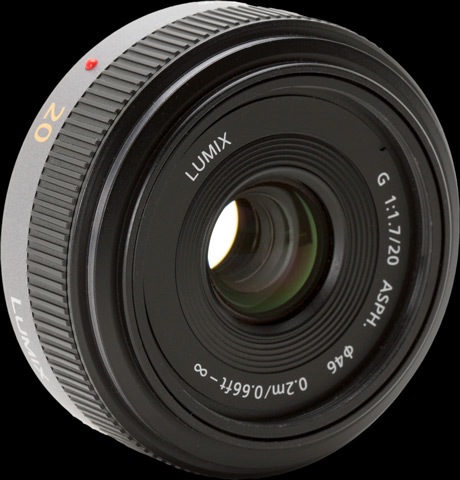State of the art.
A couple of years ago I wrote that the real digital revolution in photography gear would be fomented not by traditional manufacturers but rather by the new breed of companies specializing in electronics and modern design, unshackled by historical investments and conventions.

Never has this proved more true than with the Panasonic 20mm f/1.7 ‘standard’ lens for the G1/GH1/GF1 micro four-thirds camera range. As the excellent piece at DPReview discloses, this 40mm equivalent lens is simply state of the art, a superb marriage of hardware and corrective software design. I would go as far as to say that it is to digital what the 35mm SummicronM, in its aspherical final version, was to film. I used one of those for years and, suffice it to say, you could buy no fewer than seven of the Pannys for the ridiculous price asked for the Leica optic today, so it’s hard to complain that the Panasonic lens is expensive.
The new Panny lens peaks at f/4, just like the Leica Summicron of old (both in its 35mm and 50mm guises) and, unlike the kit zoom, does not include shake reduction. Perhaps the shake reduction on the Olympus EP1, which is built in to the body of that camera, works, but frankly the EP1 is such a poorly executed camera for street snaps (slow focus, awful shutter lag, no proper viewfinder, mediocre optics, etc. – a joke from such a great manufacturer) that it’s not like I will ever be trying it.
So why am I not rushing out to buy one? Well, I very much intended to when it was first announced but, frankly, I have become so enamored of the kit lens with its exceptionally useful 14-45mm (28-90mm on full frame) zoom range in a very small package that I no longer want to be burdened with the task of swapping lenses when snapping on the street. Or, for that matter, carrying more clutter. While f/1.7 is nice to have, the f/3.5-5.6 maximum on the kit lens is fine for my purposes, as I am not an available light maven. And the kit lens is so good I find that I am using it at or near full aperture nearly all the time, with the built in shake reduction adding 2-3 stops, effectively, in low light, making the effective aperture range more like f/1.4 to f/2.5. The only thing I miss is the shallower depth of field that a true f/1.7 offers, but the compromise more than works for me.
March 31, 2011 update: I ended up buying one of these and you can read about it here. I returned it on April 1, 2011, as this is one of the least competent street snapper lenses I have ever used – to add insult to injury the very slow autofocus comes with extreme flare, incorrect exposure on my G1 in auto mode and an inability to orient imported pictures properly in Lightroom. Other than that its great ….
The Leica M-series, being a rangefinder non-SLR, did not have zoom lenses, but some splendid ones like the Summilux, Summicron, Elmar and Elmarit, ranging from 35, 50 90 to 135 mm, besides the 21 mm Super-Angulon. They were all compact and eminently carryable, and we Leica buffs did not miss the SLRs with their bulky zooms. The Visoflex even allowed Macro with the 65 mm Macro-Elmarit by converting the M into an SLR of sorts.
The compact Lumix 40 mm (equiv.) with f/1.7 is a lens in the same tradition, but by now, even long-time users of the Leica M have become addicts of the versatile zoom lenses. It is not so much the carrying of several lenses, but the hassle of changing quickly enough when required that has made us converts. And it must be admitted that when zooms can deliver quality, there will be no room for the fixed-focal-length lenses in a photographer’s kit bag.